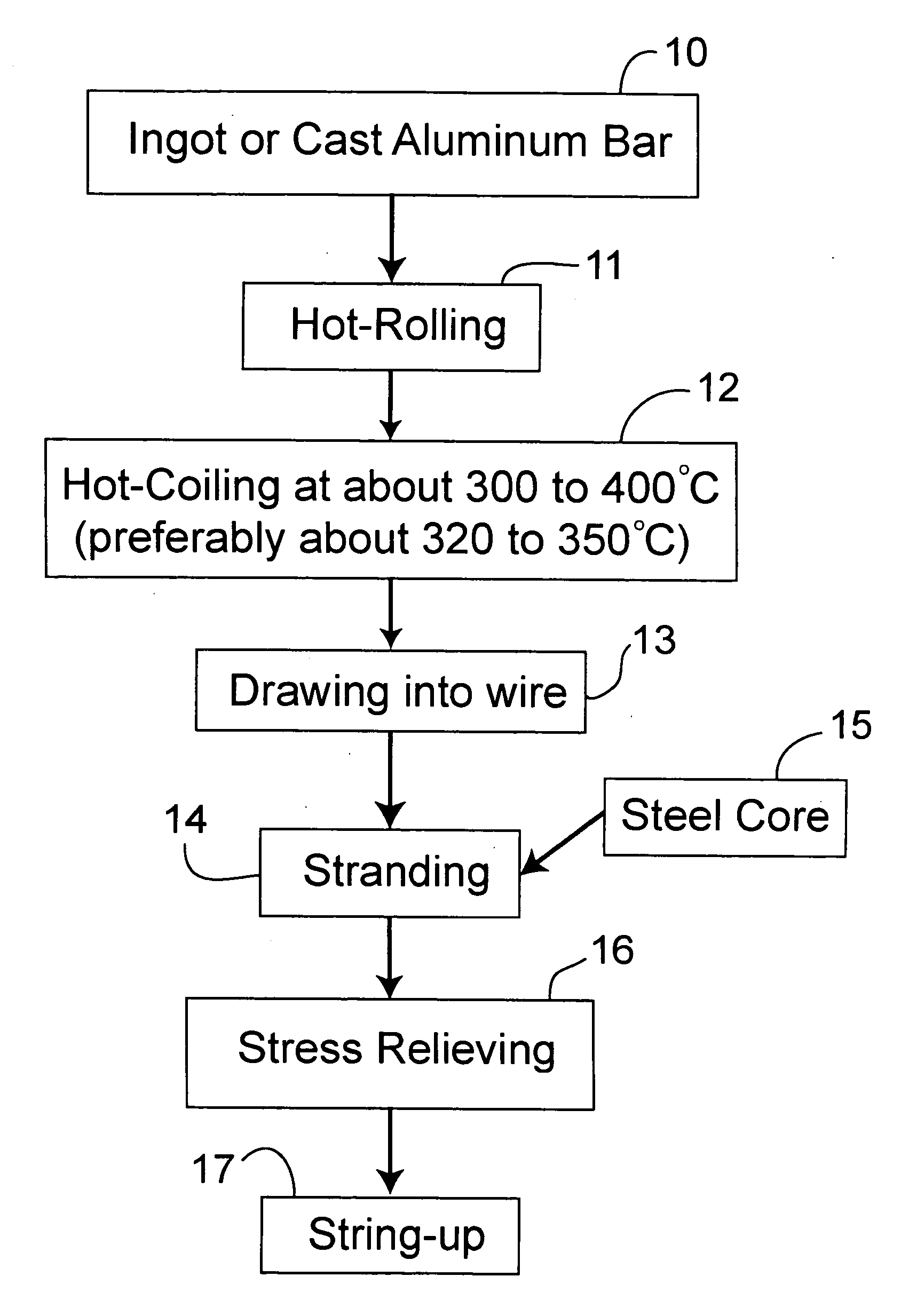Process of producing overhead transmission conductor
- Summary
- Abstract
- Description
- Claims
- Application Information
AI Technical Summary
Benefits of technology
Problems solved by technology
Method used
Image
Examples
example 1
Coiling
The aluminum rod employed in this test was LaPoint Continuous Cast AA1350 of 9.5 mm R 1.0—Coil Numbers 12438, 44, 53, 54, 49 The rod produced was “Hot Coiled” at a temperature above 300° C. and had an actual Tensile Strength of 86 to 102 MPa.
Drawing
The rod was wire drawn and rolled at 800 meters / mm 13 die Vaughn Drawbench and was spooled on 25 inch bobbins. After drawing, wire 2.7 to 3.3% Elong., the tensile strength was 120 to 141 MPa.
Stranding Set-Up Normal for producing electrical cable Approx. 10,000 feet produced
Batch Anneal (Higher than Originally Planned Due to Variable Tensile Rod) 320° C. first Hour; 300° C. for approx. 24 hrs, until T / C @285° C. for 2 hrs.
The finished conductor was in compliance with specifications.
example 2
The rod employed was Hot Coiled 1350 Aluminum 9.5 mm Rod having an electrical conductivity of 62.5 to 62.8% IACS Actual.
The rod was produced under the following conditions:
ActualBar TemperatureCoiling TempEmulsion Temp 500° C.297-300° C.52-54° C.485-500° C.291-295° C. 49° C.
The Actual Tensile Strength was 70 to 78 MPa.
Rolling Practice No. L1350-1
Entry Bar Temperature 500° C.+ / −15° C.
Emulsion Temperature 53 + / −2° C.
Diameter: 9.6 + / −0.2 mm
RollValve Position by Roll Stand NumberStand #1234567-1415Rolls33456788Guides33457880
Casting Practice # C1350-3Casting Speed RPM2.80 + / − .05Exit Bar Temperature 600 + / − 15° C.Furnace Metal Temperature 715 + / − 15° C.Metal Temperature before Casting Wheel 685 + / − 20° C.
Cooling Water on Casting WheelPressurePressureFlowModel AModel BSectionliters / min.Nominal KpaNominal Kpa255 + / − 535 + / − 5 23 + / − 5 3105 + / − 5 145 + / − 10 155 + / − 10 5———6240 + / − 1040 + / − 5 7120 + / − 5 130 + / − 5 8135 + / − 5 90 + / − 10
The finished conductor was in compliance...
PUM
| Property | Measurement | Unit |
|---|---|---|
| Temperature | aaaaa | aaaaa |
| Temperature | aaaaa | aaaaa |
| Temperature | aaaaa | aaaaa |
Abstract
Description
Claims
Application Information
 Login to View More
Login to View More - R&D
- Intellectual Property
- Life Sciences
- Materials
- Tech Scout
- Unparalleled Data Quality
- Higher Quality Content
- 60% Fewer Hallucinations
Browse by: Latest US Patents, China's latest patents, Technical Efficacy Thesaurus, Application Domain, Technology Topic, Popular Technical Reports.
© 2025 PatSnap. All rights reserved.Legal|Privacy policy|Modern Slavery Act Transparency Statement|Sitemap|About US| Contact US: help@patsnap.com


